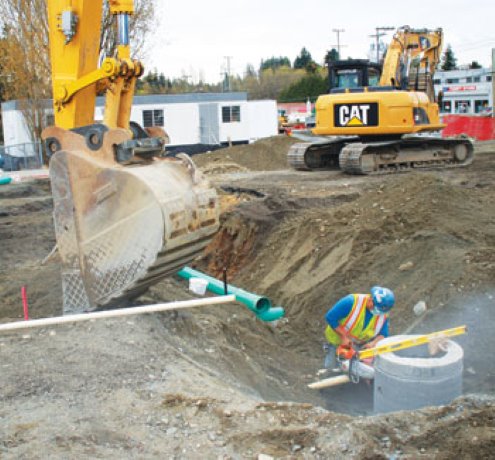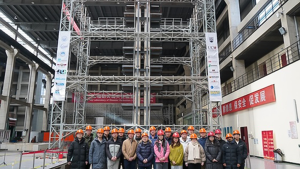Nanaimo’s largest infrastructure project is an 18-month-long bridge replacement and road upgrade currently underway on a major traffic route.
Construction well underway on Nanaimo’s biggest project
Nanaimo's largest infrastructure project is an 18-month-long bridge replacement and road upgrade currently underway on a major traffic route.
It will be completed in two phases to address environmental concerns and avoid road closures, in an area that carries an average 16,000 vehicles per day.
A bridge built in 1939 will be replaced, along with an 800-metre stretch of road and 1,200 metres of below grade water, storm and sanitary pipes.
The steel girders on the existing bridge are rusted out, said Jan Mongard, City of Nanaimo’s project manager.
The structure is also susceptible to flooding from the Millstone River that runs beneath it.
The new bridge design is a single span configuration with pre-stressed concrete box girders 1,200 mm deep, with concrete abutment and an asphalt surface.
The girders form part of the deck, making it far superior to the design of the previous bridge, said Ed Townend, project manager with AMEC, the structural engineer on the project.
The bridge was raised 1.2 metres higher than the current structure to meet the flood water requirements.
The difference in height creates a grade separation for a few hundred metres that is in some places three metres deep.
General contractors Hazelwood Construction Services will temporarily support the fill of the road with lock blocks.
A four-metre-high and 50-metre-long mechanically stabilized earth (MSE) retaining wall on the east side of the bridge rectifies the difference between the existing and finished grade.
The retaining wall is a wire mesh with cobblestone face.
City regulations stipulate that the roadway must remain open during construction, and work on the bridge can only occur between June 15 and Sept. 15 to accommodate the river’s environmentally-sensitive fish habitat.
As a result, the bridge is being constructed in two parts.
The north half will be completed first and traffic will be rerouted onto the new structure.
In the second phase, the existing bridge will be demolished and the south portion of the new bridge constructed in its place.
Once complete, the two bridges will be twinned to create one 18-metre-wide five-lane structure.
The wider bridge moves a pinch point heading into town, where traffic is squeezed down to one lane to get over the bridge, said Townend.
“This will be moved east of the bridge,” he said.
Further plans to extend the upgrade several blocks to the east are still under consideration.
The biggest challenge in the roadway design was allowing room for congested utility lines and minimizing property impacts and right of way for businesses in the area.
“The utilities seem to all come to the same point,” said Townend.
“It’s very congested.”
The work requires an intersection to be moved slightly north.
The existing road, on the south side, will become a service road for businesses in the area.
Raylec Power Ltd. is completing the electrical and traffic signal work at the intersection. Their work includes reinstating the traffic loop.
During the road upgrade, the project will see upgrades to existing sewer and water lines constructed in the 60s and 70s.
About 1,100 metres of storm pipe were upgraded from 600 mm to 900 mm diameter.
A junction point in the 750 mm supply watermain was constructed consisting of a new valving arrangement—a T-configuration—that will allow the line to continue to the north end of Nanaimo for future developments.
The upgrade also consisted of 600 metres of watermain replacement and 800 metres of sanitary pipe replacement, 200 metres of which is an upgrade to 900 mm pipes because the Millstone Collector passes through the area at Buttertubs Marsh and Bowen Road.
The utilities are upgraded using a typical open trench technique to install the pipes.
This includes excavation and disposal of the soils to an offsite location, backfill and compaction as per the specification.
Paul Noel, general manager of Hazelwood Construction Services, said that upgrading underground services without interrupting water and sewer to surrounding businesses meant providing temporary overland services.
“There is one sanitary sewer that crosses Bowen Road east of the bridge that is around six metres deep,” he said.
“We have to maintain that sewage flow because it is for a large area of Nanaimo, so there will be pumping of live sewage there. It’s a short duration – about a week.”
In advance of this work the city replaced a sanitary line that runs underneath the Millstone River in 2010.
The elevation of the other utilities is done in dry trenches.
Hydro lines over the north side of the project conflicted with the new configuration, requiring crew to relocate about 30 poles to the south side of the development.
The budget for the upgrade is $10.7 million.











Recent Comments
comments for this post are closed